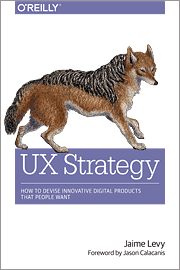
If you work with UX outside of Brazil (or have close working friends), you may have heard of the term UX Strategy - UX Strategy.
UX strategy is a long-term plan to align every customer touchpoint with your vision for user experience.
In the American market (and in some European countries), the UX Designer profession has existed and been consolidated for at least a decade in companies of various sizes and configurations. As part of the natural evolution of the discipline and with the growing importance of these professionals in the market, it is common for branches of positions and more specialized positions to arise. One of them is UX Strategist.
The same thing happened to the profession of Webmaster. Remember that? In the early days of the internet, it was common for only one professional to be responsible for designing, building, implementing and maintaining websites: the webmaster. It was only with the passage of time that this wave branched out; Little by little, the distinction between the role of the web designer and the developer appeared more clearly. Moving forward a few years later, the role of webdesigner began to be divided into smaller and more specialized roles: what was once done by only one professional, was now done by a User Experience Designer, a Visual Designer, a Motion Designer, and Some cases even a 3D Artist.
In the current scenario, this list is even more fragmented and specialized:
- User Researcher: focus your tasks on conducting user interviews and behavior analysis;
- Information Architect: focuses on tasks such as organizing the content of the site, how the search tool should work, which names to use in the menus etc .;
- Specialist or Content Strategist: focuses on tasks such as writing, structuring content to be delivered on different devices, interface texts on titles and labels etc .;
- Interaction Designer: responsible for defining the flow of interaction in an application, and how the user navigates through it. He also thinks about the transitions between the screens, usually inspired by real-world metaphors;
- Visual Designer: focuses on typography, layout, colors, graphics, visual effects, images, textures, mood;
- Front-End Developer: focuses on writing HTML, CSS, Javascript and other languages to implement a particular visual and interaction;
But what about UX Strategist? Where does this joke come in?
What does UX Strategist do?
In his book UX Strategy, Jaime Levy defines four crucial roles within UX Strategy:
Business strategy is about understanding the mission, vision and values of a company or product. How does the company view the world, and what role does it want to have in the market? How does the product differ? What tools can be used to fit all the parts that make up that product or service? And how to make this product become viable within the market in which it operates?
Value innovation is the constant pursuit for differentiation and low cost. What is the value proposition of the product or service to the consumer? Defining the value proposition is one of the great roles of UX Strategy within the project - and this definition is usually done in multiple hands, in conjunction with company stakeholders and product managers.
Researching with users is the primary way to avoid "bashing" and go for the facts. Essentially it consists of exposing a product (or a product idea) to potential users as soon as possible in the process, to validate if that product makes sense to that audience.
And finally, user experience (but those of you who are blog readers already know a lot). Briefly, it consists of understanding how the consumer will feel / feel when interacting with the product or service.
Creating a "UX strategy" can mean many things depending on the type of company and the type of professional who is responsible for that task.
Overall, UX Strategy's goal is to find connections between how your organization measures the success of a product or service and how the user measures the success of a good user experience. This intersection between usage experience and business objectives is one of the key factors for a product to have a successful launch. At the end of the strategy step, UX Strategist delivers a roadmap with everything that needs to be done to deliver the best possible user experience and the best business results for the company.
The UX Strategist's Utility Belt
Just as UX Designer has a number of methods and deliverables to get you in the shoes of consumers and design experiences that are simple, interesting and relevant to use, UX Strategist also has its own utility belt. It is these tools that allow the UX Strategy professional to deliver value within a project and lead the most strategic steps within the team.
Let's look at some of them:
- Canvas: These are maps that help stakeholders define and articulate a particular product or service at a more strategic level. These maps highlight the most important parts of a product, and allow business hypotheses to be validated early in the project. These canvases can acquire different formats and templates, but some of the most famous ones are the Business Model Canvas and the Lean Canvas (more focused on startups).
- Competitive analysis: allows you to understand the approach that your direct and indirect competitors use when delivering your product or service to the consumer. In this analysis, the UX strategist checks the functionalities, performance, goals and strategies of each of the competitors - organizing everything so that it is possible to compare the current situation of the market in a comparative way. It is also possible to investigate how each competitor positions itself strategically in relation to vision and values, processes and functionalities.
- Environmental Analysis: is an assessment of other factors (other than competitors) that can affect your product or service. This analysis usually looks at attributes such as the technology available, and the social, legal, and economic factors that govern the current market situation. Understanding the macro scenario where the product will be released may be essential to the success or failure of a new release.
- Research with Users: These methods are also commonly used by UX Designers, and may include ethnographic research, quantitative surveys, or in-depth interviews - all aimed at understanding in more detail how the consumer behaves, thinks, and acts in relation to that type of product or service In which you are working.
- Personas and maps of the user's journey: everything that is learned through research with consumers can be documented by the UX Strategist through people and journeys. In practice, it is different ways of understanding and visualizing who the consumer is and what path he goes through when interacting with that type of service.
But does UX Designer no longer do all that?
Does. In some cases. The big difference is that in the US market (and in some Brazilian companies as well), having a UX Strategy professional focused on the more strategic steps of product definition has two clear advantages for the project.
The first of these is to lighten UX Designer's workload. In larger projects, the strategic definition stage can take a lot of time - especially when it is planned to do several consumer interviews, or a more detailed ethnographic study. In these cases, the UX Strategy professional is the leader in this type of activity, releasing more time for UX Designer to focus on tasks that are directly related to the user flow, wireframes, prototypes.
The second is that the profile of the professional who thinks about the strategy is a little different from the professional who executes the design. There are cases in which the same professional is able to take care of everything - but often getting the same professional to float with such dexterity between strategy and execution can be a nightmare for recruiters. What some companies choose to do, then, is to separate "UX" into two different positions: UX Strategist and UX Designer. The combination of these two types of professionals (and the way of thinking of each one of them) certainly brings benefits to the project, since its different perspectives balance well the business side and the user side of the product.
I'm slowly sharing more about UX Strategy here. But for now, if you want to know more: http://uxstrat.com/blog/what-is-strategy/


Downvoting a post can decrease pending rewards and make it less visible. Common reasons:
Submit